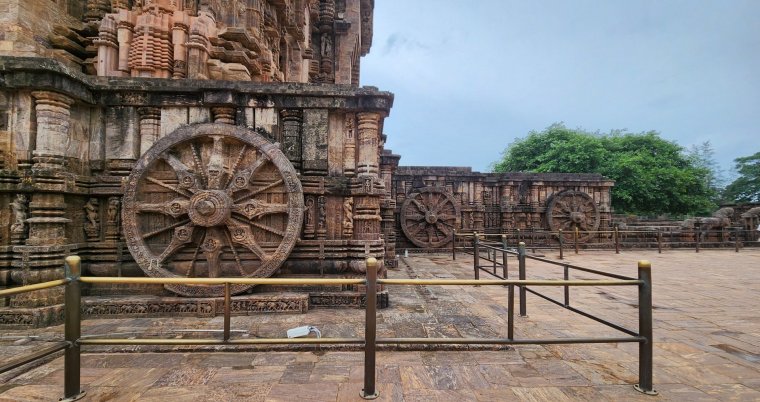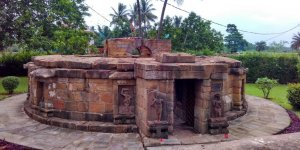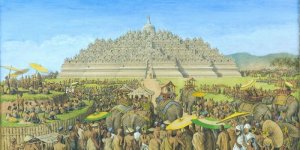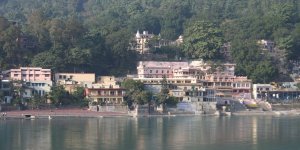| Published in Attractions / Temples, Ashrams, Monasteries |
Konark Sun Temple, Odisha, India
The Sun Temple at Konark, located in Odisha, India, is a remarkable 13th-century monument dedicated to the Hindu sun god Surya. Built around 1250 CE during the reign of King Narasimha I of the Eastern Ganga dynasty, this architectural marvel is renowned for its unique design and intricate sculptures.

Konark Sun Temple panoramic view. Credit: Alokprasad84, Wikipedia
The temple is designed to represent Surya's massive chariot, featuring 24 elaborately carved wheels and led by a team of seven horses. This impressive structure once stood at a height of about 227 feet (69 m), though much of the main sanctuary and its towering superstructure have collapsed over time.
Unique architectural features
Chariot design: The entire temple complex is designed to represent the massive chariot of the Sun god Surya, with 24 intricately carved wheels and seven horses.
Sundial functionality: The 24 wheels of the chariot are not just decorative - they function as precise sundials, capable of telling time accurately to the minute.

Wheels have intricate symbolic carvings. Credit: Daniel Stefanita
Symbolic elements: The 24 wheels represent the 24 hours of the day, while the seven horses symbolize the seven days of the week.
Orientation: The temple is oriented east-west, allowing the first rays of the rising sun to fall directly on the main entrance.

Credit: Daniel Stefanita
Structural layout: The complex consists of a main shrine (vimana), an audience hall (jagamohana), and a separate dance hall (natya mandapa).
Pyramidal roof: The jagamohana features a terraced pyramidal roof with three tiers, adorned with life-sized sculptures of women in various poses.
Intricate carvings: The temple's exterior is covered with elaborate sculptures depicting deities, mythological scenes, daily life, and erotic imagery.

Simha-gaja at the entrance. Credit: Daniel Stefanita
Use of magnets: According to some accounts, the temple's peak originally contained 52 tons of magnets, arranged in a way that caused the main idol to float in air.
Multiple sun god images: Three images of Surya were positioned to catch the sun's rays at dawn, noon, and evening.
Building materials: The temple was constructed using three types of stone - chlorite, laterite, and khondalite - some of which were imported from other countries.
These architectural features showcase the advanced knowledge of astronomy, engineering, and artistry possessed by the builders of the Konark Sun Temple in the 13th century.

Temple entrance. Credit: Daniel Stefanita
Rituals performed at the Sun Temple today
While the Sun Temple at Konark is no longer an active place of worship, some rituals and ceremonies are still performed there:
Chandrabhaga Mela: This annual festival takes place in February near the temple site. Devotees gather to take a holy dip in the Chandrabhaga river and pay homage to the Sun god.
Special ceremonies: Occasionally, special homa (fire ceremonies) and abhisheka (water ceremonies) are performed for the temple deities by priests from Konark.
Bhumi Pujan: In 2022, the Archaeological Survey of India (ASI) performed a Bhumi Pujan (ground-breaking ceremony) before starting work to remove sand from the temple's garbhagriha (sanctum sanctorum).
Daily rituals: While regular worship doesn't take place inside the main temple structure, some daily rituals may be performed in the temple complex or nearby shrines.
Surya Namaskar: Visitors often perform Surya Namaskar (sun salutations) at the temple site, especially at sunrise.
It's important to note that the main idol is no longer present, and regular worship rituals have not been performed inside the temple for many years. The temple is primarily maintained as an archaeological and historical site rather than an active place of worship. However, it continues to hold spiritual significance for many Hindus, who visit to pay respects to the Sun god and appreciate the temple's religious symbolism and architectural beauty.
Legends associated with the Konark Sun Temple
Legend of Samba: According to Hindu mythology, the temple was built by Samba, son of Lord Krishna. The story goes that Samba was cursed with leprosy by his father. He prayed to Surya (the Sun God) for 12 years and was cured. In gratitude, Samba built this magnificent temple dedicated to Surya.
The Floating Lodestone: A popular legend claims that a powerful lodestone (magnet) was placed at the top of the temple. This magnet supposedly caused the main idol to float in mid-air. Some versions say there were 52 tons of magnets used in the temple's construction.
The Mysterious Builder:
One tale speaks of a 12-year-old boy who appeared mysteriously and offered to build the temple in just 12 days. The king agreed but added a condition - if the boy failed, he would have to sacrifice his life. On the final day, when the dome was yet to be placed, the boy disappeared. Some say the king's son climbed to the top and sacrificed himself to complete the temple.
The Curse of Dharmapada:
According to this legend, the chief architect Dharmapada's son Dharma solved a construction problem that had stumped the senior artisans. Fearing for their reputation, the artisans murdered Dharma. When Dharmapada learned of this, he cursed the temple, leading to its eventual ruin.
The Portuguese Attack:
Some local stories attribute the temple's partial destruction to Portuguese sailors. They allegedly tried to remove the lodestone from the temple's peak, causing the structure to collapse and killing many devadasis (temple dancers) in the process.
The Haunted Temple:
Building on the previous legend, some locals believe the temple is haunted by the spirits of the devadasis who died during its collapse. There are claims of hearing the sound of anklets and ghostly laughter at night.
While these legends add to the mystique of the Konark Sun Temple, it's important to note that they are not historically verified. The temple's actual history, as supported by archaeological evidence, attributes its construction to King Narasimhadeva I of the Eastern Ganga Dynasty in the 13th century.
Sources
https://timesofindia.indiatimes.com/
https://en.wikipedia.org/
https://www.britannica.com/
YOU MAY ALSO LIKE





 If you own or manage a travel-related business such as a hotel, a bed-and-breakfast, a restaurant, a pub or a cafeteria, you can create a web page for your business for free on Titi Tudorancea Travel Info. » |
